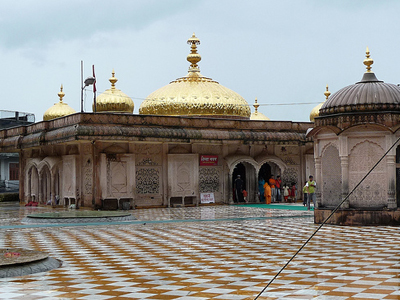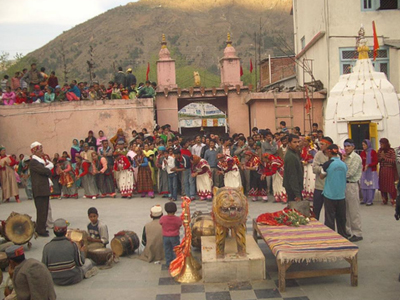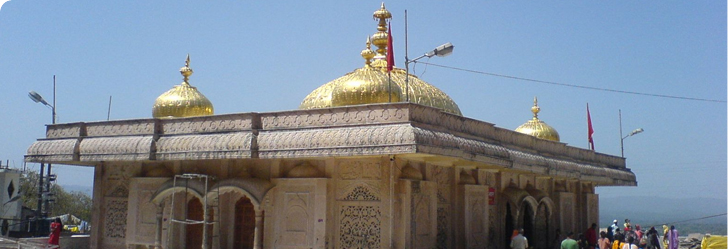Jwalamukhi Temple Kangra

30 kms south of Kangra valley in the lap of Shivalik range and 56 kms from Dharamshala, the Jwalamukhi temple is dedicated to the "GODDESS OF LIGHT".
One of its own kinds of temples, there is no idol in it. An eternally burning and shining blue flame emanating from a rock sanctum is only worshipped here as a manifestation of the goddess. Dedicated to the deity of Flaming Mouth or goddess Jwalamukhi, the temple is one of the 51 power spots or Shaktipeethas of India. One of the most revered temples of the Hindus, the temple possesses a golden dome, gifted by Mughal Emperor Akbar. The temple is at its best during Navratri festival in early April and mid October.
History of Jwalamukhi Temple ( Kangra ) - Himachal Pradesh
Dating back to the origin of Adishakti or Sati, the temple basks in a glorious past. It was to get respite from the unending atrocities of the demons that the gods concentrated their individual energies at one point, thus giving birth to Sati. Brought up in the house of Prajapati Daksha, Sati got married to Lord Shiva later.
Once Prajapati Daksha organized a yajna and invited al the gods and goddesses to it barring Lord Shiva. Sati wanted to partake in this grand affair so she reached the place of the Yajna uninvited. All her sisters were welcomed by her father there except her. Daksha did not even dedicate the sacred portion of the Yajna Prasad to Lord Shiva. This made Sati feel immensely humiliated. Therefore, she immolated herself in the fire of the Yajna.
Sati's end disturbed the Lord Shiva immensely. He sliced Daksha's head. On his reparation, the Lord affixed the head of a male goat to him. Unable to restore his mental peace even then, He roamed in the entire universe carrying Sati's burnt body. Foreseeing a calamity approaching, the gods requested Lord Vishnu to diffuse the anger of Shiva. At this, Lord Vishnu cut apart Sati's body into several pieces with his Sudharshan Chakra. Wherever those pieces of sati's body fell on earth, a shaktipeetha or the power centre of the goddess came up.
The Jwalamukhi temple is the place where Sati's tongue fell. The goddess therefore is manifested as tiny flames here that burn through the fissures in an age old rock. There are nine flames at the temple that have been burning here without any oil or cotton since ages.

The temple also has a great historical significance dating back to the reign of Mughal emperor Akbar. Amazed at the continuity of these flames, he tried to extinguish these. He tried a lot of methods for this but in vain. Finally, he submitted to the power of the goddess. He went to the shrine bare footed and presented a golden umbrella to the goddess. But the goddess denied this offering and the Chhatra turned into a colossal metal. Maharaja Ranjit Singh of Punjab also paid a visit to the temple in the year 1809. The building of the temple has a gilt dome gifted by Maharaja Ranjit Singh and silver plated folding doors.
Inside the temple, there is a 3 feet square pit with pathway all around. In the centre of which is a hollowed rock over a primary fissure of flame. This one is regarded as the mouth of Mahakali. Nine flames in total emanate from different points in the pit and represent Saraswati, Annapurna, Chandi, Hing Laj, Vindhya Vasini, Mahalakshmi, Mahakali, Ambika and Anjana - the forms of goddess. Thousand of devotees flock the temple round the year to pay homage to the goddess and to get their wishes fulfilled.
Hotels & Resorts
- Hotels in Shimla
- Hotels in Manali
- Hotels in Dharamshala
- Hotels in Dalhousie
- Hotels in Parwanoo
- Hotels in Shilon Bagh
- See More ...
Featured Tours
- Himachal Holidays
- Himachal Magic Tour
- Himachal Tour
- Complete Himachal Tour
- Himalaya Shimla Tour
- Himalaya Travel Packages
- See More ...



